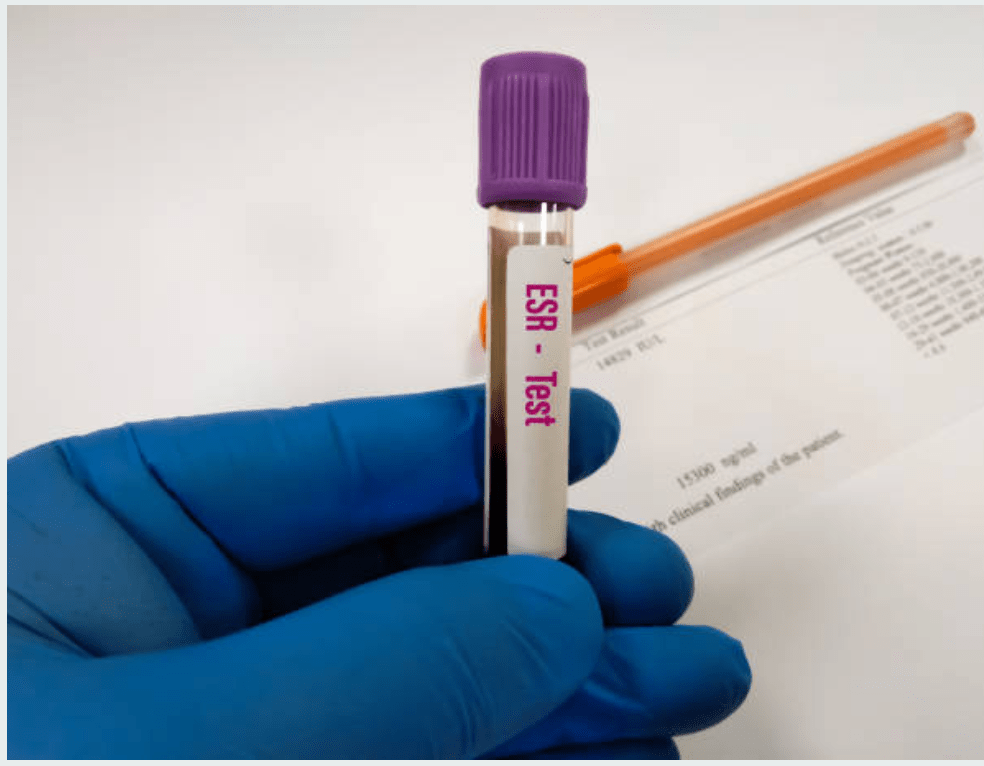Erythrocyte Sedimentation Rate ( ESR ) Test
Changes in various serum proteins occur in acute infections during active phases of chronic inflammation. In acute infections tissue injury related inflammatory response lead to increase in serum proteins such as fibrinogen , globulins , C – reactive protein ( CRP ) and serum amyloid A protein ( SSA ) and decrease in albumin. Erythrocyte Sedimentation Rate ( ESR ) Test perform various following methods .
- Westergrens method
- Wintrobe method
- Microsedimentation method or Landau method .

ESR by Westergrens method
Clinical significance
- ESR is increased in all conditions where there is tissue breakdown or where there is entry of foreign proteins in the blood except for localized mild infections . The determination is useful to check the progress of the disease . If the patient is improving the ESR tends to fall . If the patient’s condition is getting worse the ESR tends to rise .
- The changes of ESR are however not diagnostic of any specific disease .
Method Name
Westergrens method
Normal range
| Male | 0 – 15 mm after 1 hours |
| Female | 0 – 20 mm after 1 hours |
Specimens
- Small tube ( 100 × 10 mm ) with 2.5 ml mark is used for blood collection ( If the tube is not graduated pipette out 2.5 ml of 3.8 % sodium citrate in the tube and after marking the level of fluid remove 2.0 ml of the solution leaving 0 .5 ml of the anticoagulant in the tub ) .
- The tube with 0.5 ml 3.8 % sodium citrate should be kept ready before blood collection .
- Patient should be fasting for 12 to 16 hours . Collect blood by venipuncture and add in the tube upto the mark and mix carefully .
Requirements
- Westergrens ESR tube
- Stand for holding the tube
- Timer of watch
Procedure
- Fill the Westergrens tube exactly upto zero mark by means of a rubber bulb ( avoid air bubbles ) .
- Place the tube upright in the stand . It should fit evenly into the groove of the groove of the stand .
- Note thr time .
- Allow the tube to stand for exactly one hour .
- Exactly after one hour note the level to which the red cell column has fallen .
- Report the result in terms of mm / after 1 hour .
Precautions : –
- Wash the tubes as early as possible under running tap water .
- Rinse in deionized water and dry in the incubator between 40 – 50 °C .
ESR by Wintrobe method
Specimen
Fresh fasting EDTA anticoagulant and undiluted blood . ( It is necessary to draw at least 2 to 3 ml of blood for both CBC and ESR determinations ) .

Normal Range : –
| Male | 0 – 9 mm/ after 1 hour |
| Female | 0 – 20 mm / after 1 hour |
Requirements
- Wintrobe tube
- wintrobe tube stand
- Pasteur pipette or 2 ml syringe with needle
- Timer or watch
Procedure
- Mix the blood carefully .
- Fill the wintrobe tube to the zero mark by using a pasteur pipette or by using a syringe
- palce the tube in exactly vertical pasition in the stand . Set timer for one bour .
- At the end of one hour note the level of erythrocytes column in terms of mm after 1 hour .
Precautions
- Wash the tubes under running tap water by introducing a thick wire in the tube repeatedly to remove the packed cells completely . Afterwards dry the tubes in the incubator .
- In the case of infants and if blood quantity is insufficient use Landau method .

ESR by Microsedimentation ( Landau ) method
Specimen
Fasting capillary blood ( finger tip , hell or toe )
Normal range
| Male | 0 – 5 mm after 1 hour |
| Female | 0 – 8 mm after 1 hour |
Requirements
- 5.0 g /dl sodium citrate solution
- Landau pipette this pipette resembles RBC pipette . It is graduated from 0 to 5 mm .
- Landau pipette stand
- Suction device for drawing blood into the pipette .
- Capillaries for blood collection .
Procedure
- Attach the Landau pipette to the suction device .
- Draw 5.0 g /dl citrate up to first line on the stem .
- Now draw blood by suction device upto second mark on the stem ( avoid air bubbles ) .
- Wipe excess blood on the external side of the pipette .
- Draw citrate solution and blood into the bulb of the pipette . Mix the contents thoroughly .
- Force back the mixture of the stem of the pipette .
- Set the upper level of the mixture to the zero mm mark at the top .
- Detach the suction device .
- Place the pipette in vertical position or the stand . Set the timer for one hour .
- Note the reading ( the distance red cells has fallen ) after one hour .
